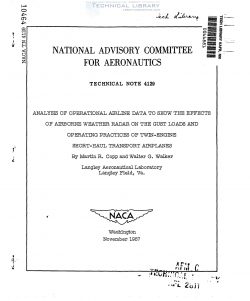naca-tn-4129
- Version
- 120 Downloads
- 877.90 KB File Size
- 1 File Count
- February 2, 2017 Create Date
- February 2, 2017 Last Updated
National Advisory Committee for Aeronautics, Technical Notes - Analysis of Operational Airline Data to Show the Effects of Airborne Weather Radar on the Gust Loads and Operating Practices of Twin Engine Short-Haul Transport Airplanes

Samples of airspeed, altitude, and acceleration measurements obtained
from transport operations utilizing airborne weather radar have been eval—
uated to determine the effects of radar storm detection on the magnitudes
of the gust velocities, gust loads, and operating airspeeds. The data
samples were Obtained with NACA V-G and VGH recorders installed in twin-
engine short—haul commercial transports;
The results indicate that the magnitudes of the largest gust veloci—
ties and gust accelerations experienced for a given number of flight miles
during operations with airborne radar were approximately 25 percent less
than those experienced before the radar equipment was installed. However,
airborne radar appeared to have no appreciable effect upon the frequency
of occurrence of the smaller repeated gust loads. Inasmuch as the airspeed
practices in rough air were not affected by the use of airborne radar, the
reduction in the magnitudes of the largest gust accelerations appeared to
be due mainly to the avoidance of storm areas which were detected by the
radar.
The development of airborne weather radar has provided a useful
means of locating thunderstorm rain areas. Inasmuch as these rain areas
are normally severely turbulent, weather radar thus provides a means of
locating and avoiding such turbulent areas.' Flight tests with radar—
equipped airplanes have indicated that storm avoidance through the use
of airborne radar could result in a reduction in gust loads and improved
passenger comfort. (See, for example, refs. 1 to A.) As a result of
these and other possible benefits, a number of airlines have recently
installed airborne weather radar in their airplanes. However, no
quantitative information has, as yet, been obtained on the magnitudes of
the effects of airborne weather radar on the gust loads in actual airline _
operations.
| File | Action |
|---|---|
| naca-tn-4129 Analysis of Operational Airline Data to Show the Effects of Airborne Weather Radar on the Gust Loads and Operating Practices of Twin Engine Short-Haul Transport Airplanes.pdf | Download |

Comment On This Post